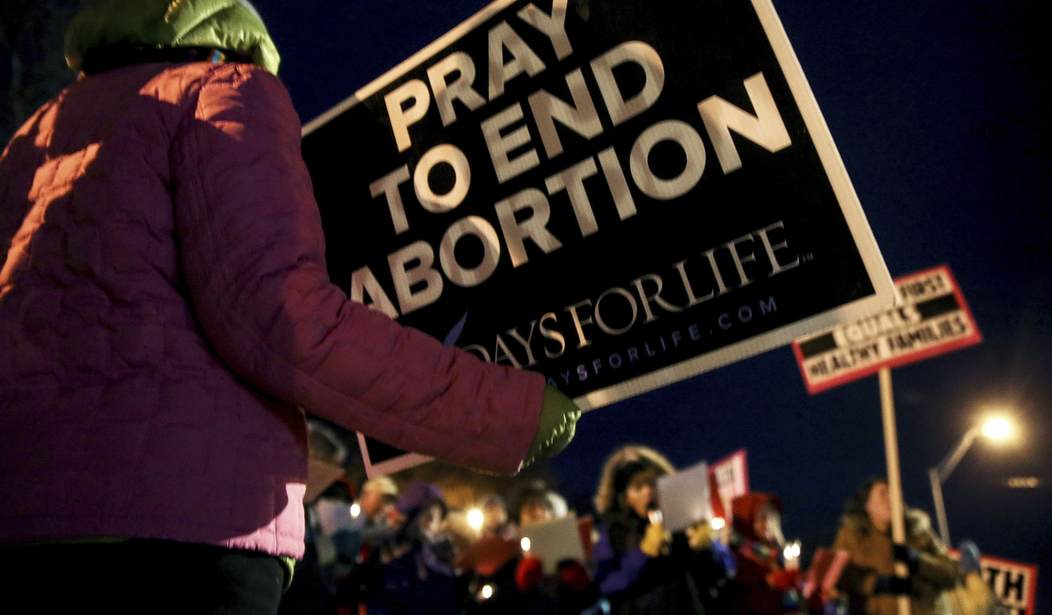Even in our era of politics without precedent, few things are as inexplicable as the Democratic Party's decision to take increasingly extreme positions on abortion while so much of the country moves in a different direction.
The March for Life, held annually in Washington, D.C., around the anniversary of Roe v. Wade, is one visible example of the country's mood on the U.S. Supreme Court decision legalizing abortion. The number of participants in the march continues to grow each year. Last week's March for Life was notable not only for its size (no official numbers are available, but video footage suggests well over 100,000 people) but because Donald Trump became the first sitting U.S. president to address the march, drawing additional national (and international) attention to the event.
Commentators have observed that fully half of the marchers are college-aged or younger. ("We are the pro-life generation" is a popular sign seen at the march.) This may well suggest a generational shift in perspective, which poses interesting electoral consequences for the future.
The number of abortions has dropped dramatically over the past 30 years. The Guttmacher Institute released a report in September of last year stating that the number of abortions had dropped 19% between 2011 (1,058,000 abortions) and 2017 (862,000 abortions), and the abortion rate (number of abortions per 1,000 women ages 15 to 44) dropped by 20% during the same time period. This is part of a steady downward trend from the all-time high of over 1,420,000 abortions in 1990.
Guttmacher's policy stance is pro-abortion, and the report's authors take pains to state that abortion restrictions passed by 32 states in recent years are not responsible for the decline in abortions. Given that this trend started years earlier, that conclusion seems reasonable. However, they cannot definitively identify any other specific cause(s) for the decline.
Recommended
Perhaps it is the advent of modern medical technology, which has pushed fetal viability back to 22 weeks. (A handful of children born at 21 weeks have survived.) Fetal surgery has become a growing specialty, and surgeons can now repair heart defects and hernias, correct spina bifida and remove tumors while the child is still growing and developing in the womb. Even those whose babies are not dealing with medical emergencies in utero or born prematurely can see the humanity of the unborn child in traditional ultrasound (which did not exist when Roe v. Wade was decided) or the more advanced 4D ultrasound.
Further, research on fetal neurological development suggests that the unborn child can feel pain at around 20 weeks; this revelation has prompted a number of legislative initiatives to severely limit abortions after that gestational age. The most recent work -- conducted by a Planned Parenthood consulting physician -- puts the fetal pain threshold even earlier, at 13 weeks.
Much better scientific knowledge about fetal development, therefore, might well be driving down the abortion rate.
So, too, might widespread shock and revulsion at some of the abortion industry's horror stories exposed in recent years.
The corpses of over 2,000 dead fetuses were found in the home and car of former Illinois and Indiana abortion doctor Ulrich Klopfer after he passed away last year. In 2015, undercover journalist David Daleiden released a series of videos in which Planned Parenthood physicians and staff members appeared to be discussing the sale of fetal body parts, performing abortions so as to best preserve the organs of unborn children for sale and other ghastly practices. In 2013, Philadelphia abortion doctor Kermit Gosnell was convicted of three counts of murder (among other crimes) in the deaths of babies born alive after abortion attempts, who Gosnell subsequently killed by cutting their spinal cords with scissors. Gosnell's trial exposed not only the grossly unsanitary conditions of his clinic, the illegal abortions performed by untrained staff members, and the grisly "trophies" he kept in jars and boxes but also -- most disturbingly -- the complete failure of government oversight.
Is it any wonder that a majority of Americans favor reasonable regulations on abortions, such as mandatory medical disclosures and ultrasounds, brief waiting periods, hospital admitting privileges for physicians performing abortions, and parental notification laws for minor girls seeking abortions?
So where is the Democratic Party on abortion?
Last year, the Democratic-controlled New York legislature passed the Reproductive Health Act, which permits abortion at any time until birth. The law removed the restriction requiring abortions to be performed by a physician. And it removed any references to an unborn child from New York's penal code -- meaning that someone who attacks a pregnant woman and kills her child in utero cannot be prosecuted for the death of that child. It also removes any requirement to provide medical care for a baby that survives abortion.
California and Illinois -- both states controlled by Democrats -- have also passed laws expanding abortion. California now requires all private health insurers to cover abortion. Illinois' 2019 law removed its prior ban of partial-birth abortion and states that no "fertilized egg, embryo, or fetus does not have independent rights" under Illinois law. Virginia's legislature, controlled by Democrats since the 2018 midterm elections, is removing previous regulations including the requirement that abortions be performed by a physician, mandatory counseling and a 24-hour waiting period.
This year's Democratic presidential candidates are just as strident. At a town hall in Des Moines, Iowa, last Sunday, former South Bend, Indiana, Mayor Pete Buttigieg was asked by voter Kristen Day if the Democratic Party still has room for pro-life Democrats. Day, the executive director of Democrats for Life of America, stated that this amounts to 21 million voters.
Buttigieg punted. In later interviews, Day concluded that there is no longer any place for pro-life Democrats in her party.
If leading Democrats aren't interested in the views of a majority of Americans, or millions of their own voters, just who are they trying to please?

























Join the conversation as a VIP Member